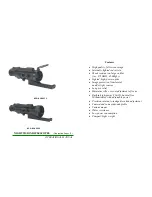
object, such as the Moon or a bright star, and
use the viewfinder’s alignment screws to
make any necessary refinements.
5. When finished, turn off the red dot
viewfinder by rotating the on/off switch(20)
counter-clockwise.
UNDERSTANDING CELESTIAL
MOVEMENTS AND COORDINATES
Understanding where to locate celestial
objects and how those objects move across
the sky is the key to enjoying the hobby
of astronomy. Most amateur astronomers
practice “star-hopping” to locate celestial
objects. They use star charts or astronomical
software to identify bright stars and star
patterns as “landmarks” in their search for
astronomical objects. Another technique
for locating objects is to use the setting
circles that are provided on your
telescope.
UNDERSTANDING HOW CELESTIAL
OBJECTS MOVE
Due to the Earth’s rotation, celestial bodies
appear to move from East to West in a curved
path through the skies.
All stars and celestial objects are mapped
onto an imaginary sphere surrounding the
lock knob (7) before rotating the RA axis
to prevent the counterweight from sliding
unexpectedly. When the telescope is
balanced, proceed to aligning the red dot
viewfinder.
ALIGN THE RED DOT VIEWFINDER
Perform the first part of this procedure
during the daytime and the last step at night.
1. Point the telescope at an easy-to-find land
object such as the top of a telephone pole or
a distant mountain or tower. Look through
the eyepiece and turn the focuser knob (31)
until the image is sharply focused. Center
the object precisely in the eyepiece’s field
of view.
2. Turn on the red dot viewfinder by turning
the on/off switch(20) clockwise.
3. Look through the red dot viewfinder
(24). Turn one or more of the viewfinder’s
alignment screws (34) until the red dot
is precisely over the same object as you
centered in the eyepiece.
4. Check this alignment at night on a celestial
Looking at or near the
Sun
will cause
irreversable
damage to your eye. Do not point this telescope at or near the Sun. Do not look through the telescope as it is moving.
Fig. 6
7































